#african american abstract expressionist artists
Text

Norman Lewis
Untitled (Head of a Mule, French Sudan)
1935
#norman lewis#modern art#abstract expressionist#abstract expressionist art#abstract expressionism#abstraction#abstract art#black artist#african american art#abstract painter#art history#american art#aesthetictumblr#tumblraesthetic#tumblrpic#tumblrpictures#tumblr art#tumblrstyle#aesthetic#artists on tumblr
23 notes
·
View notes
Text

Sam Middleton was born in 1927 in New York City and grew up in Harlem at the height of the Harlem Renaissance. In 1944, he enlisted in the Merchant Marines at age 17 and returned to New York in the 1950s. There he befriended other New York School artists such as Franz Kline, Jackson Pollack, and Robert Motherwell.
Middleton, who was largely self-taught, often saw jazz masters like Thelonious Monk and Charlie Parker play live in the 1950s, and was inspired to translate the spontaneity of their music to works on paper. He incorporated music sheets, newspapers, tickets, magazines, and cards he’d collected into his collages, famously attaching them with Elmer’s glue.
In 1955, Middleton made his first artistic trip outside of New York. Following the lead of other African American artists who were in search of a more open-minded atmosphere, Middleton settled briefly in Mexico City. It was in Mexico that his style shifted from social realism to abstract expressionism. By 1959, he resolved to leave the US permanently. He spent time traveling to Spain, Sweden, and Denmark, and eventually settled in the Netherlands in the 1960s. He formed many close friendships during his time in Europe, spending time with artists and intellectuals such as Herbert Gentry and James Baldwin. Middleton passed away in the Netherlands in 2015.
Middleton’s work has been exhibited nationally and internationally and can be found in the collections of the Whitney Museum, the Brooklyn Museum, the Columbus Gallery of Fine Arts, Fisk University Galleries, the Hampton University Museum, and the Howard University Museum, as well as in private collections all around the world.
Featured Work:
PFF137 - "Love Day," Mixed media on paper, 1963, 39 x 34 in.
#abstract art#african american art#black art#black art in america#sam middleton#black artists#abstract expressionist art#mixed media art#harlem renaissance#PFF Collection
40 notes
·
View notes
Text










Richard Mayhew, b 1924 of African American and Native American ancestry.
Born in 1924 and raised in Amityville, New York, on Long Island’s south shore, Richard Mayhew’s passion for painting was sparked by watching the artists who summered in the environs of Amityville and painted its scenic shoreline. Inspired by these artists, young Mayhew used brushes and paints from his father’s sign painting business to copy what the artists were doing. When Richard Mayhew was 14 years old, one of the artists recognized the young man’s talent and taught him the fundamentals of drawing and painting. Throughout his teenage years, Richard Mayhew made several trips into New York City to study the works of the European and American masters on view at The Metropolitan Museum of Art. By age 17, he had made up his mind to become an artist.
For Richard Mayhew, the essence of reality is more important than its facts. His landscape paintings aren’t the facts of a landscape but the spirit of a landscape. That spirit shimmers through a haze saturated with color.
His emotional and spiritual connection to the natural world has its roots in his African American and Native American ancestry: his father was African American and Shinnecock; his mother, African American and Cherokee. During his boyhood, his paternal grandmother supported his art endeavors and schooled him in the Native Americans kinship with the earth.
After his service as a Montfort Point Marine, Mayhew moved to New York in 1947, a crucial period in American art history. Abstract Expressionism, the first truly homegrown American art movement, was electrifying the public, igniting passionate discussions among the cognoscenti about what constitutes art in the first place and what is its purpose in the public realm. Richard Mayhew, now a student at the Brooklyn Museum’s school of art, with additional courses at Pratt Institute and Columbia, thrived in this fevered environment. The painterly freedom of the Abstract Expressionists had a profound influence on Richard Mayhew, opening his canvases to the wild essence of being that was in kinship with the spirituality of his heritage.
167 notes
·
View notes
Text
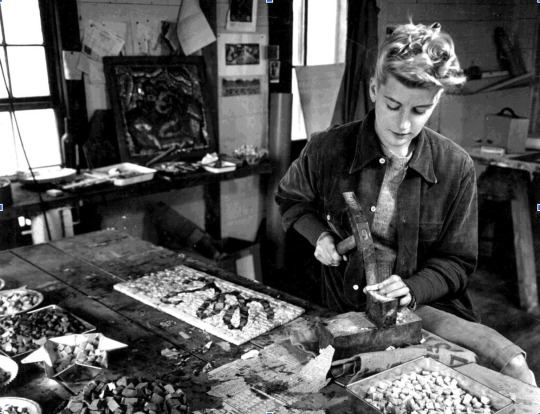
Jeanne Reynal B.1903, WHITEPLAINS, NEW YORK D. 1983
Jeanne Reynal (1903-1983) is a significant figure of the New York School, a mosaicist who showed with Betty Parsons Gallery. Reynal was dedicated to challenging expectations of the medium by creating, as she described, “a new art of mosaic, a contemporary and fresh look for this ancient medium.” Her work was largely abstract.
Born in White Plains, NY, Reynal apprenticed from 1930-38 with Boris Anrep, a Russian mosaicist working in Paris. This established her interest in working with the medium. Reynal spent the World War II years living in San Francisco, and in Sierra Nevada. Her first solo exhibition was held in Los Angeles in 1940.
Reynal���s father died in 1939, allowing her resources with which to build an art collection. She acquired a 1941 Jackson Pollock painting from Peggy Guggenheim’s gallery -- one of the first ever sales of a Pollock. At this time, Reynal developed a relationship with the first director of the San Francisco Museum of Modern Art: introducing her to the work of Pollock and other first-generation New York School artists, and helping to set the course of acquisitions and exhibitions at the museum. Reynal’s closest artist friend was Arshile Gorky, and his wife Agnes (known as Mougouch). Reynal would show her own work in the SFMoMA Annual exhibitions from 1940-46. During her West Coast years, Reynal also developed a friendship with Isamu Noguchi who had enrolled, voluntarily, in an internment camp to aid other Japanese-Americans. She would later collaborate with Noguchi on mosaics for tables of his design. Reynal was also associated with the Surrealists - many of whom were living in exile in the U.S. In 1945, Reynal took a six week visit to the Hopi, Zuni, and Navajo Indians with André and Elissa Breton as interpreter and guide.
Reynal moved to New York City in 1946. At that time, she further developed friendships with artists including Willem and Elaine de Kooning. In 1955, she married Thomas Sills, a largely self-taught African American painter. They traveled together across Russia, Turkey, Greece, and Italy in 1959 to further study the art of mosaic. In 1960, she was asked, by Elaine de Kooning, to take over the organization of a show of Abstract Expressionist women artists held in West Texas in 1960, at Dord Fitz Gallery. It was in this period that Reynal began exhibiting with Betty Parsons.
Reynal was the subject of a traveling solo exhibition, organized by the San Francisco Museum of Modern Art, in 1964. The same year, a monograph of her work, with essays by Elaine de Kooning, Dore Ashton, and Lawrence Campbell, was published. The solo show traveled to the Sheldon Museum in Lincoln, Nebraska, a city where, the following year, Reynal would create mosaic murals for the State Capitol building.
Reynal traveled with her husband, Sills, throughout South and Central America: Mexico, Guatemala, Honduras, Peru. She was influenced by indigenous art throughout her travels. In the early 1970s, Reynal began making totem sculptures utilizing mosaic tesserae and pieces of shell. These monumental works were exhibited at Betty Parsons and at the Art Association in Newport, Rhode Island. In the late 1970s, she made a series of portraits in mosaic (many of artist-friends), and depictions of animals.
Eric Firestone Gallery
27 notes
·
View notes
Text

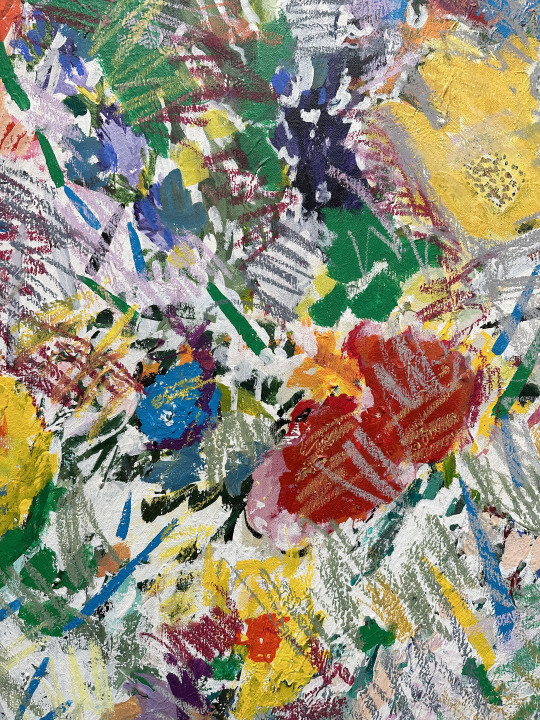

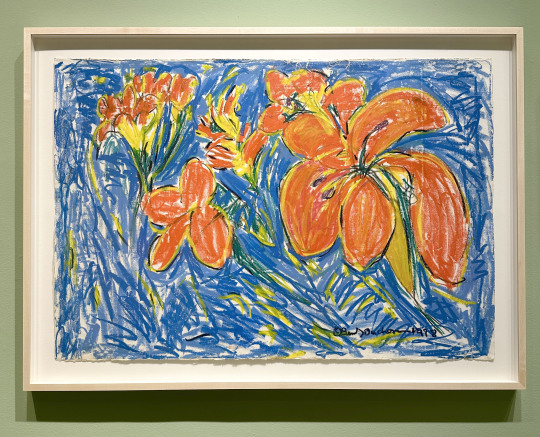
Andrew Edlin Gallery is currently showing a collection of rarely seen works by artist Beverly Buchanan. It covers her years as an abstract expressionist painter in NYC and her later work inspired by the rural South.
The gallery’s press release gives a really good history of this wonderful artist-
The first section of the show features the artist’s abstract paintings and works on paper from the 1970s, alongside post-minimalist sculpture from the late 1970s and early 1980s. The second section introduces a later, more personal side of Buchanan’s oeuvre, her colorful depictions of flowers and small folk-inspired assemblages created during the same period as her well-known “shacks.” A number of the works in the show, many of which were part of the artist’s private collection, have never been shown.
Though Buchanan wrote about her love of “making things” from an early age, it wasn’t until 1971, when she began taking evening classes taught by African-American painter Norman Lewis (1909-1979) at the Art Students League in New York, that her career as an artist took off. Abstract still-lifes that she made in Lewis’s class in 1972 are displayed here for the first time. That same year, her paintings were included in a group show at Cinque Gallery, a nonprofit space co-founded by Lewis and Romare Bearden (1911-1988), which showcased the art of emerging minority artists.
Having witnessed demolition sites in Harlem and SoHo, Buchanan evoked the visual erosion of architectural facades through what she dubbed her “Wall” paintings. In 1976 she presented a selection that she called “Torn Walls” in a two-person show titled City Walls at the Montclair Art Museum in New Jersey. In his New York Times review, David Shirey described the show as “indisputably a tinderbox of a display that will cause sparks to fly” and “the kind …one sees more regularly at the Whitney Museum and at some of New York’s avantgarde galleries.” Three of these paintings are being shown for the first time since that exhibition, forty-seven years ago. The show also includes a monotype, small studies, and a large painting from a series she titled “Black Walls.” The latter was originally featured in Shackworks, a seminal exhibition that opened at the Montclair Art Museum in 1994 and traveled to nine other institutions from 1994-1996.
By the late 1970s, Buchanan was further exploring the aesthetics of architectural decay through sculpture, i.e., cast concrete assemblages, made from pieces of stone, brick debris, clay, and cement mixtures. She arranged these works in clusters on the floor, documenting them with photographs, and exhibited them, notably at Truman Gallery in New York in 1978, and at the feminist artist cooperative A.I.R. Gallery in 1980 in its groundbreaking show Dialectics of Isolation, curated by Ana Mendieta. Some of the small black terracotta works on display may be considered as studies for these larger assemblages.
After moving to Georgia in 1977, Buchanan became increasingly interested in making what she referred to as “environmental sculpture,” artworks that mimicked exterior surfaces and were also site-specific installations that were allowed to decay over time and become part of the surroundings. Most notably, in 1979 she completed Ruins and Rituals (also the title of the Brooklyn Museum retrospective from 2016-2017), and in 1980 Marsh Ruins, with funding from a Guggenheim Fellowship. To construct the three mounds that comprise Marsh Ruins, Buchanan produced her own tabby cement. Composed of the lime from burned oyster shells mixed with sand, water, ash, and other shells, tabby is what colonial settlers used to build structures in coastal Georgia, the location of Marsh Ruins. In her zine “Making Tabby for Brick Sculptures,” Buchanan documented the labor-intensive process of making tabby, a task that in the eighteenth century was typically delegated to enslaved workers. Two smaller iterations of these structures, with bits of oyster shell showing in the concrete, are laid out in the show alongside four other examples of her cast concrete assemblages. Though little is known about their exhibition history, we do know that the artist placed these cast concrete works in her garden in Athens, Georgia. They retain stripes of the green, blue, black and earth-toned paint with which Buchanan initially covered them. The faint outline of her signature “B.B.” is also visible.
Buchanan’s later work is intimately linked to her natural surroundings and folk art. As a native Southerner, she drew on memories from her childhood as well as the lush Georgian landscape and yard art of local self-taught artists. A passionate gardener, Buchanan produced vivid oil pastel flower drawings and small assemblage works. She loved to rummage through thrift stores collecting marbles, wedding toppers, and beads, to create what she referred to as her “Christmas trees,” and “spirit jars,” her take on memory jugs, a prized Southern Folk Art form. Buchanan was particularly moved by a visit to folk artist Nellie Mae Rowe’s home in Fayette County, Georgia, and reminisced: “Being at Nellie Mae Rowe’s home was like being engulfed in a magic forest of her work because every surface had a mark from her hand and the simple chewing gum works made you never take gum as just chewing gum again.” A distinctive chewing gum jug and pin are also included in the show.
This exhibition closes 5/13/23.
#beverly buchanan#andrew edlin gallery#andrew edlin#nyc art shows#art#art shows#painting#drawing#sculpture#abstract expressionist#flower paintings#american folk art#american south
8 notes
·
View notes
Photo

Vincent DaCosta Smith (December 12, 1929 – December 27, 2003) was an artist, painter, printmaker, and teacher. He was known for his depictions of African American life. At 17, he enlisted in the army and traveled with his brigade for a year. It wasn't until after his time in the army that he began to paint and printmaking. At the age of 22, he was working in a post office where he grew to be friends with fellow artist Tom Boutis. He was a figurative painter who used abstractions and materiality to make something new. His work depicts the rhythms and intricacies of African American life through his prints and paintings. Many of his paintings and prints rely heavily on patterns. According to Ronald Smothers, his work "stood as an expressionistic bridge between the stark figures of Jacob Lawrence and the Cubist and Abstract strains represented by African American artists like Romare Bearden and Norman Lewis." He has described his work as "a marriage between Africa and the West." Over his life, he worked in both painting and printmaking. He won the John Hay Whitney Fellowship which allowed him to travel to the Caribbean for a year. During this year he was deeply inspired by the customs and lifestyle of the native people. He attended various art schools but it was not until turning 50 he returned to college to earn an official degree. From 1967 until 1976 he taught at the Whitney Museum’s Art Resource Center. He taught printmaking at the Center for Art and Culture of Bedford Stuyvesant. #africanhistory365 #africanexcellence https://www.instagram.com/p/CmER9ItLieL/?igshid=NGJjMDIxMWI=
2 notes
·
View notes
Link
0 notes
Text
Sylvia Snowden
Sylvia Snowden is an African-American artist, who lives and works in Washington D.C.
“I do not believe in an artist’s statement for me because it seems to narrow the viewer’s reaction and direct him/her to draw specific limitations. In my work, I hope to evoke stimulating responses.” - Sylvia Snowden
Snowden decided to make portraits of people around her all of whom she encountered in her Shaw neighborhood in Washington, D.C. They look abstract and don’t see faces in these portraits. The drama of Snowden’s subjects, and the sheer grace of their ability to survive and thrive, references the strength and delicate beauty in the human figure that her art celebrates. From dark and earthy tones to the vibrant and artificial, Snowden’s command of chromatic range is the fuel of her expressionistic style. She encapsulates the psychological essence of her subjects; their deliberations, triumphs, angst, and joy are all laid bare.
Sylvia Snowden holds both Bachelor of Arts and Master of Arts degrees from Howard University (Washington, D.C.). Snowden has taught at Cornell University (Ithaca, NY), Howard University (Washington, D.C.), and Yale University (New Haven, CT). In 2018, Snowden’s work was notably featured in the landmark exhibition Magnetic Fields: Expanding American Abstraction, 1960-Today at the National Museum for Women in the Arts (Washington, D.C.). Her works have been shown globally in Chile, the Netherlands, Ethiopia, Australia, the Bahamas, France, Mexico, Italy and Japan.
Image 1: Sylvia Snowden, ‘Brown - Yo II’, 1989
Image 2: Sylvia Snowden, ‘M Street - Francine 11 (Haberon Series)’, c. 1978


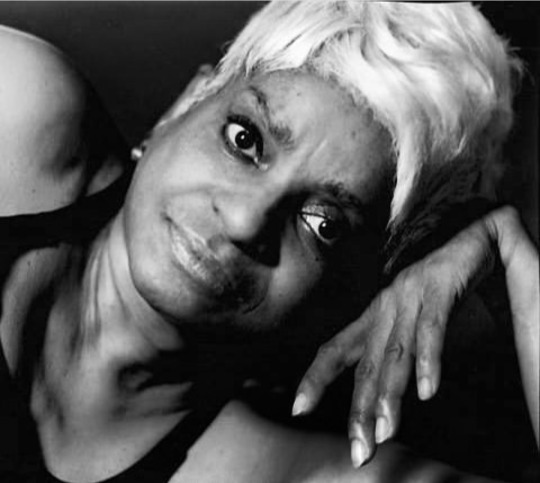
#sylviasnowden#spiritnowlondon#artprize#FriezeWeek#FriezeSpotlight#FriezeMasters#fitzwilliammuseum#franklinparraschgallery#femaleartists
0 notes
Text
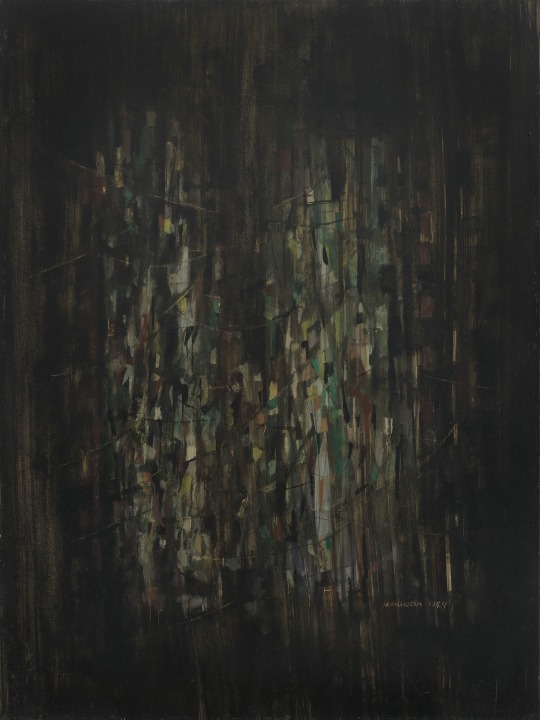
Norman Lewis
City Night
1949
#norman lewis#abstract expressionism#abstract expressionist art#abstract expressionist#abstract painter#black artist#black painters#african american art#modern art#art history#american art#aesthetictumblr#tumblraesthetic#tumblrpic#tumblrpictures#tumblr art#tumblrstyle#aesthetic#artists on tumblr
28 notes
·
View notes
Photo
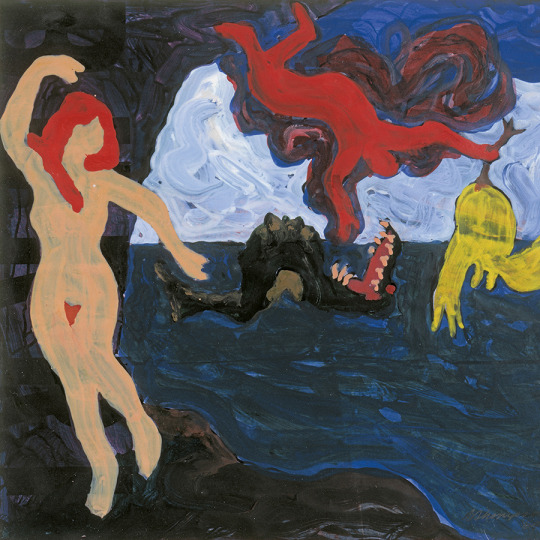
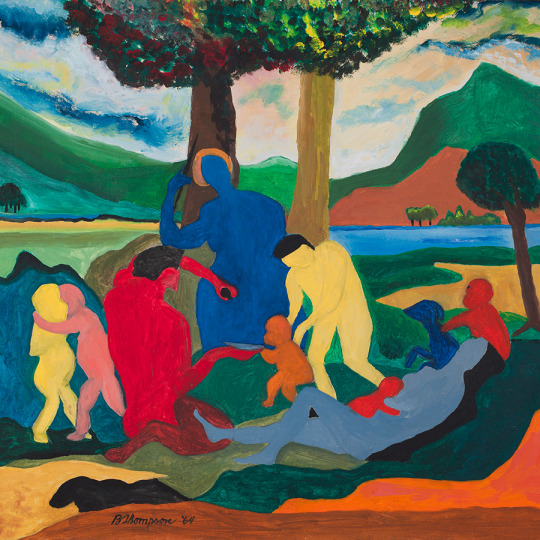
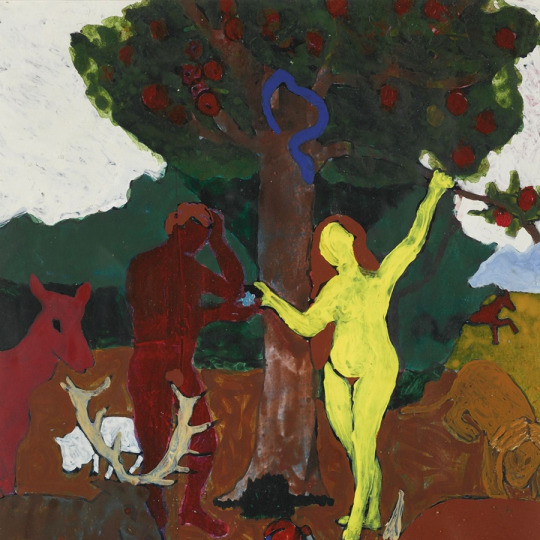

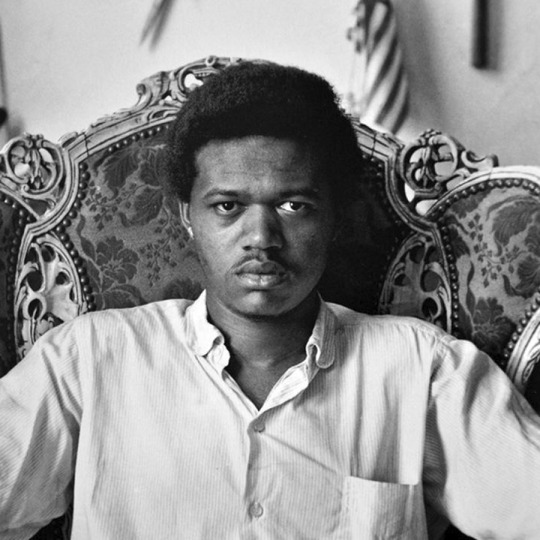

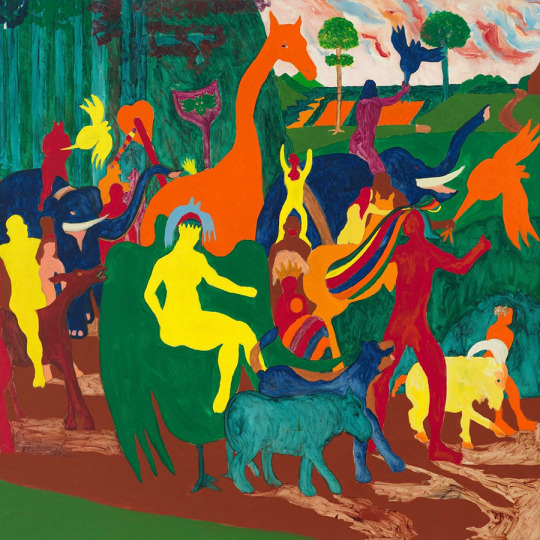

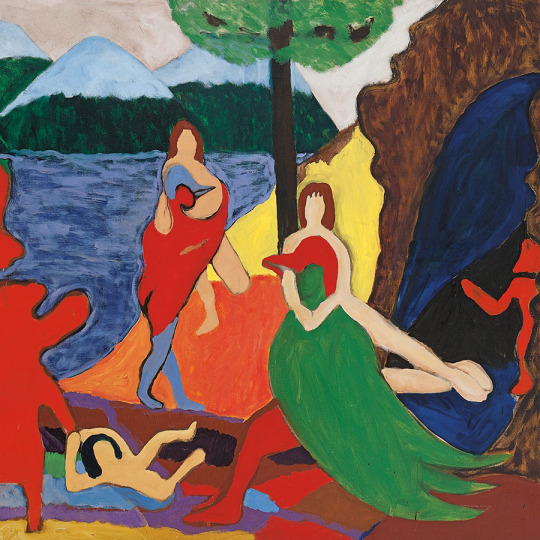
Artist I Like Series
Bob Thompson 1937-1966 an African-American figurative painter known for his bold and colorful canvases, whose compositions were influenced by the Old Masters. His art has also been described as synthesizing Baroque and Renaissance masterpieces with the jazz-influenced Abstract Expressionist movement.
#Bob Thompson#painter#male artist#20th century art#american#artist I like#art history#art#art inspo#fave#petal talks
1K notes
·
View notes
Text

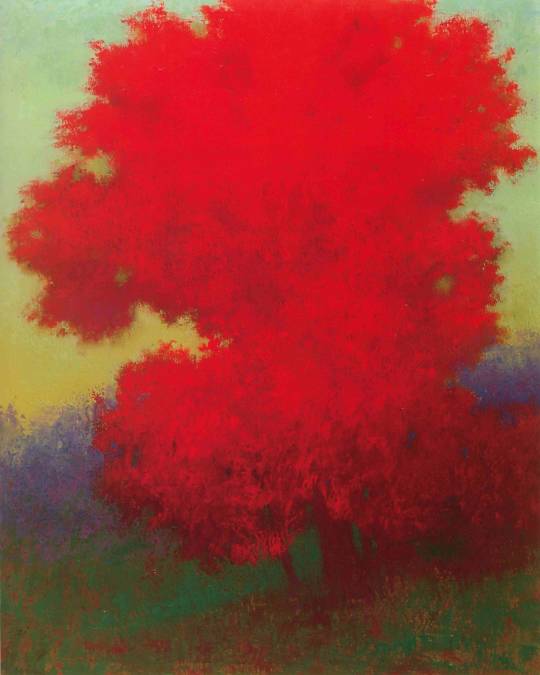
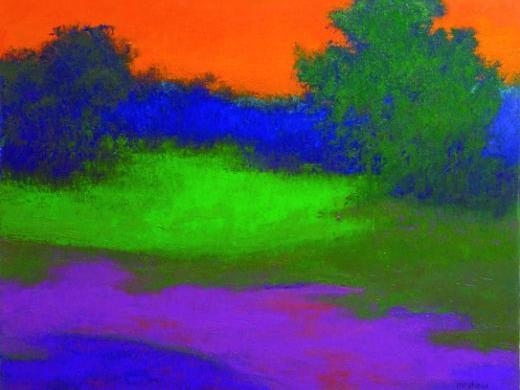
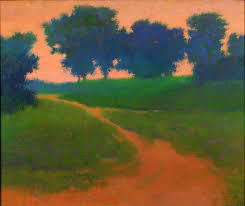
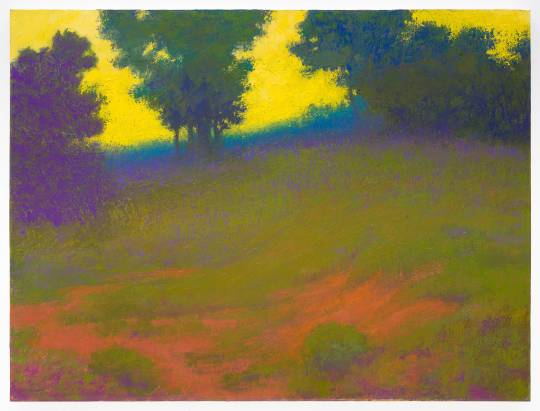


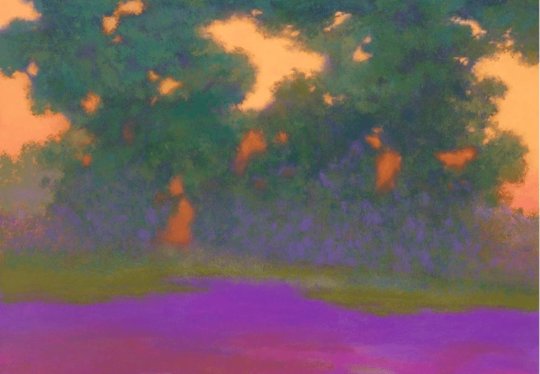


Richard Mayhew, b 1924 of African American and Native American ancestry.
Born in 1924 and raised in Amityville, New York, on Long Island’s south shore, Richard Mayhew’s passion for painting was sparked by watching the artists who summered in the environs of Amityville and painted its scenic shoreline. Inspired by these artists, young Mayhew used brushes and paints from his father’s sign painting business to copy what the artists were doing. When Richard Mayhew was 14 years old, one of the artists recognized the young man’s talent and taught him the fundamentals of drawing and painting. Throughout his teenage years, Richard Mayhew made several trips into New York City to study the works of the European and American masters on view at The Metropolitan Museum of Art. By age 17, he had made up his mind to become an artist.
For Richard Mayhew, the essence of reality is more important than its facts. His landscape paintings aren’t the facts of a landscape but the spirit of a landscape. That spirit shimmers through a haze saturated with color.
His emotional and spiritual connection to the natural world has its roots in his African American and Native American ancestry: his father was African American and Shinnecock; his mother, African American and Cherokee. During his boyhood, his paternal grandmother supported his art endeavors and schooled him in the Native Americans kinship with the earth.
After his service as a Montfort Point Marine, Mayhew moved to New York in 1947, a crucial period in American art history. Abstract Expressionism, the first truly homegrown American art movement, was electrifying the public, igniting passionate discussions among the cognoscenti about what constitutes art in the first place and what is its purpose in the public realm. Richard Mayhew, now a student at the Brooklyn Museum’s school of art, with additional courses at Pratt Institute and Columbia, thrived in this fevered environment. The painterly freedom of the Abstract Expressionists had a profound influence on Richard Mayhew, opening his canvases to the wild essence of being that was in kinship with the spirituality of his heritage.
24 notes
·
View notes
Text

#finishedbooks The Quilts of Gee's Bend by Susan Rubin. It was last year when looking for collage materials in used magazine piles that I would just check the dates because basically any magazine just after George Floyd would actually have black people in it and randomly found a contemporary quilting magazine (Fiber Now) that was really interesting. Then after being awarded an artist's grant (that they later revoked on a technicality), I booked that museum trip to Minneapolis and got to see the quilts in person (most prominently Bisa Butler) and was taken by the lines, color, movement, and texture. Fast forward to last month on a photowalk, I passed by a quilt shop and decided to walk in and told them I wanted to make quilts...and they said I can. So I borrowed my grandma's sewing machine (working simultaneously on four quilts at the moment) and checked the library and found two quilting books that I thought would be interesting and this is the first of the two. Gee's Bend is an old plantation town in Alabama made up of former slaves who just happened to have a quilting tradition that all the women took part in and are some of the most beautiful objects I have ever seen. They are at once at an intersection of folk art and contemporary while fitting right at the base of African American tradition....as it simply came out of necessity. The town, being sustained off of sharecropping, was hit so hard during the depression that it actually became a focus of Roy Stryker's FSA program that brought down Dorothea Lange to shot the town, which later garnished some New Deal allocated funds. But in her images you can see the beautifully made quilts everywhere while all the walls feature a literal collage of any paper they could find for insulation in what was made the poster child of abject poverty in America....yet it was intuitively aesthetic. I had seen these photos (one is in my next collage post) but didn't realize they were from Gee's Bend prior. Decades later during the civil rights era, MLK Jr. came to Gee's Bend to give a speech and a civil rights worker noticed these beautiful quilts all over the town, bought a few, and sent them to some prominent figures up north. People started coming in and buying the quilts (Jackson Pollock among them) and soon the women made a co/op that became the first black owned business in Wilcox county formerly the poorest county in the US and had an exclusive contract with Bloomingdale's. However, a lot of their spontaneous and anamorphic forms became rigid if not completely sterile to where a lot of the women quit and contracts fizzled out. In the 1980s, a curator who just happened to see a quilt in the background of a newspaper photograph tracked it down to Gee's Bend and asked if he could buy it. Bewildered the quilter agreed and said all the women in town are quilters. He bought from them all eventually setting up a nonprofit to track, purchase, and preserve them. The Museum of Fine Arts Houston held an exhibition (that exhibition book is rare) and by the next year they were in the Whitney and gone international. Just an interesting story that really spans the African American experience from immediate emancipation through sharecropping and the depression to civil rights and now ... cultural commodification (if not being too cynical). Regardless...in making something out of nothing, these are the most beautiful abstract forms I have ever seen in any medium that predated Rothko and the abstract expressionists by over half a century. And similar to a Rothko, they evoke a visceral experience from the stories they tell and all the pain of our experience that makes you want to (and you actually can) wrap yourself in it ...and in turn it warms you.
22 notes
·
View notes
Text
Alpha’a X Moletni&C: A Love Letter to Design in NYC

Alpha’a recently wrapped up an inspiring project curating a collection for Molteni&C’s new New York flagship store.
Molteni&C has been at the forefront of the Italian design industry for decades. All of the modern design firm’s furniture is made in Italy but it has an international presence with hundreds of retail spaces in over 80 countries.
Our in-house curator Iman Mazhar worked closely with the leading Italian furniture and design firm to highlight local NYC and East Coast artists alongside world renowned artists. The result is a vibrant collection that complements the space and creates an inspiring dialogue about design.

As a nod to Moldenti&C’s forward thinking approach to design, we sourced works that experiment with form: textured and layered paintings, minimal pieces, works with geometric patterns, as well as some sculptural and 3D works. We selected warm vibrant colors and hues of blue to add vibrancy to the showroom’s interior and included monochrome works to add moments of calmness.
Mazhar worked with Alpha’a artists, independent artists and gallery represented artists to create a dynamic roster of artists for the final selection. Alpha’a artists David Stephen Johnson and Senem Oezdogan were highlighted as well as works from artists from Praxis Gallery, Opera Gallery, Nohra Haime Gallery, and Hemingway African Gallery.
Molteni&C’s New York store is located on Madison Avenue in the heart of Manhattan. The building was designed by Vincent Van Duysen and combines Italian style and elegance with classic New York design.The spacious two story storefront is over 12,500 square feet with four large shop windows that offer passersby a peek into Molteni&’s stunning display.
Shoppable designs by the Group’s three brands: Molteni&C, Dada and UniFor fill the New York space alongside prints installed by Alpha’a. Moletni&C’s open layout imagines a range of settings for the brands’ furniture to shine, from an intimate home setting to a contemporary office environment. All artworks displayed at the store are available for purchase on site.
Meet the artists in the Molteni&C X Alpha’a collection and purchase their works on alphaa.io:

David Stephen Johnson , Alpha’a
David Stephen Johnson is an abstract painter based in Westport, Connecticut who often works with large scale canvases, exploring color and shape. He is self taught and is influenced by post-war abstract expressionists and great action painters.

Senem Oezdogan, Alpha’a
Senem Oezdogan is a Brooklyn-based mixed-media artist who uses color and form to create optical illusions. Smooth gradients give a sense of volume to the bold shapes that are subsequently flattened by her illusionistic use of spatial composition.
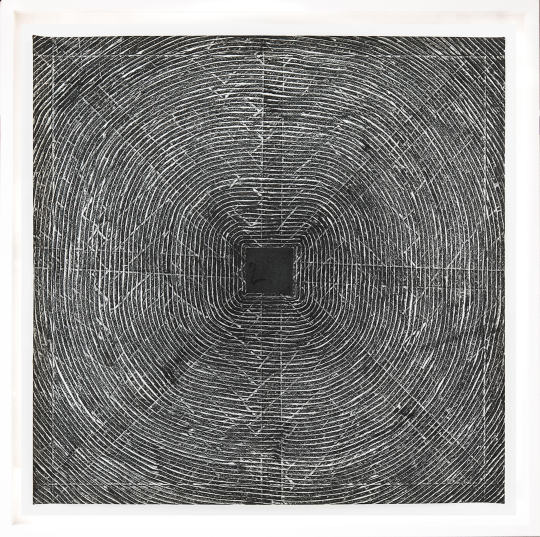
Claudia Vieira, PRAXIS
Claudia Vieria lives and works in Porto Alegre, Brazil and New York City. She recreates spaces by drawing and painting on the walls. She often creates site-specific installations and immersive drawn environments in which the action of drawing the line is as important as the final appearance of the work.

Julie Hedrick, NOHRA HAIME GALLERY
Julie Hedrick is a Canadian-American artist known for her abstract and vibrant oil paintings. Hedrick’s art displays a characteristic peeling texture, tactile complex surfaces and an elemental human quality.
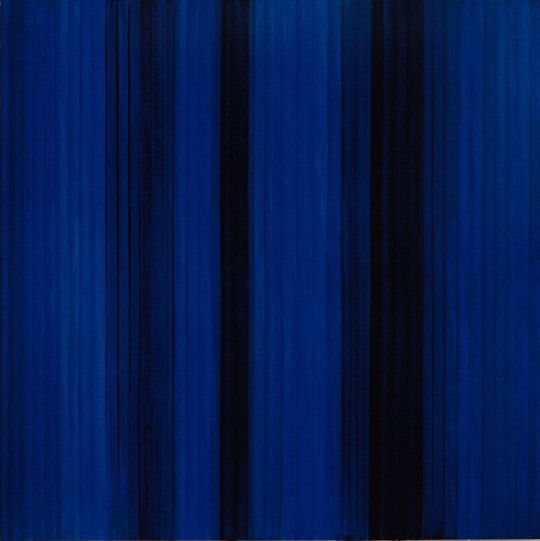
Francisca Sutil, NOHRA HAIME GALLERY
Francisca Sutil is a Chilean painter known for her research of the chromatic surface and the relationship between color and light. She uses her work to encourage reflection and meditation. She creates prints and drawings on textured handmade paper, pigmented gesso surfaces, and vertical oil bands she calls Spaces.

Sophia Vari, NOHRA HAIME GALLERY
Sophia Vari is a world-renowned Greek visual artist. She specializes in bronze sculpture and is also known for collages, oils, and watercolors and her use of patina along with contrasting colors. Her work is an investigation of form and balance.
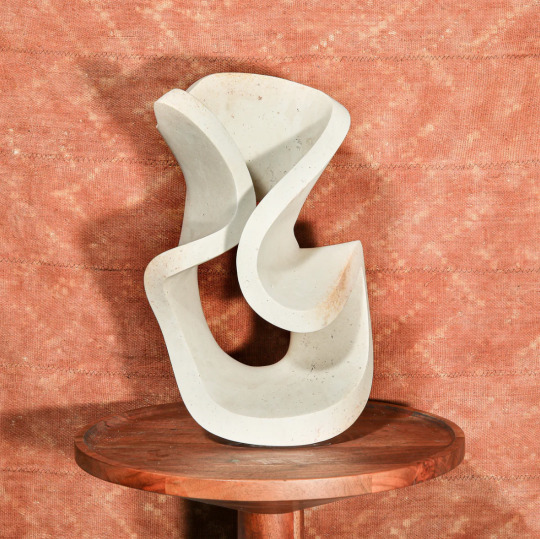
Hemingway African Gallery
Alpha’a selected sculptures from Hemingway African Gallery. The NYC gallery’s collection is ethically-sourced, often directly from artisans across the continent, and ranges from antique to decorative.

Alfred Haberpointner, OPERA GALLERY
Alfred Haberpointner is an Austrian sculptor who uses wood as his primary medium. He is best known for his wooden plates that he cuts, burns, saws and then bleaches and re-pigments creating a texture, rhythm, intensity and movement.
#alphaaio#alphaainc#nft#nftart#furniture#furniture design#new york#new york city#sculpture#modern art#abstract art#interior design#curator#art curator#contemporary arts#contemporary artist#contemporary art#new york artist#molteni#molteni&c
2 notes
·
View notes
Text

The artist I chose was Ed Clark because I immediately connected with the example picture that Professor Prince posted. I ventured out to learn more about him, and I came across his painting titled Taos from 1982, located at the Studio Museum in Harlem, New York.
I chose to reinterpret Taos, because I loved Clark's experimental process of blending colors. Stylistically, I incorporated the pink aesthetic of his color palette, but Clark's was more calm and earthy, and mine was more fluorescent and high energy.
My paint strokes mirror Clark's gestural approach. It's experimental, yet there is a zen-like presence and a focus that I aimed to achieve.
During my research on Ed Clark, I explored the financial side of his artwork, and I learned that the highest price of one of his sold works was $750,000. Stylistically, he is known in the Abstract Expressionist community for his vibrant use of color and elliptical-shaped canvases. His signature move is to use a broom to push paint around.
Clark has exhibited globally, but he has deep Chicago roots, and the Art Institute of Chicago is active in preserving his legacy. As an African-American painter in a racially divided time, he moved to Paris to be an artist where his race wasn't a focus like it was in America. He said, “his work was not about race and he did not see the need for there to be any distinction between how a white man makes a painting versus a black man.”-Art and Object
It was a pleasure to learn more about Ed Clark because his legacy and impact on the next generation of artists are still unfolding.
I loved Jeff Falco's Surrealism project because I connected with his imaginary world. The sunglasses with animated eyes were a move I enjoyed, and I stylistically loved his clouds and color palette. Great work, Jeff!
5 notes
·
View notes
Link
0 notes
Photo

Jean-Michel Basquiat “Cultural Icon” - #ArtinCulture born December 22, 1960, Brooklyn, NY. #JeanMichelBasquiat was an American artist of #Haitian and #PuertoRican descent. He was best known for his gestural style of painting with graffiti-like images, scrawled text, and his collaboration with pop artist Andy #Warhol. Lacking any formal training, #Basquiat created highly expressionistic work that mixed graffiti and signs with the gestural and intuitive approach of #Abstract Expressionist painting. Although much of his work addressed his personal angst in highly stylized self-portraits, he also alluded to African American historical figures, including jazz musicians, sports personalities, and writers. He appropriated and freely mixed motifs from #African, #Caribbean, #Aztec, and #Hispanic #cultures and mixed “high art” references with images from popular culture, especially #cartoons. #everythangculture (at Brooklyn, New York) https://www.instagram.com/p/CSYc5Cmr0lk/?utm_medium=tumblr
#artinculture#jeanmichelbasquiat#haitian#puertorican#warhol#basquiat#abstract#african#caribbean#aztec#hispanic#cultures#cartoons#everythangculture
8 notes
·
View notes